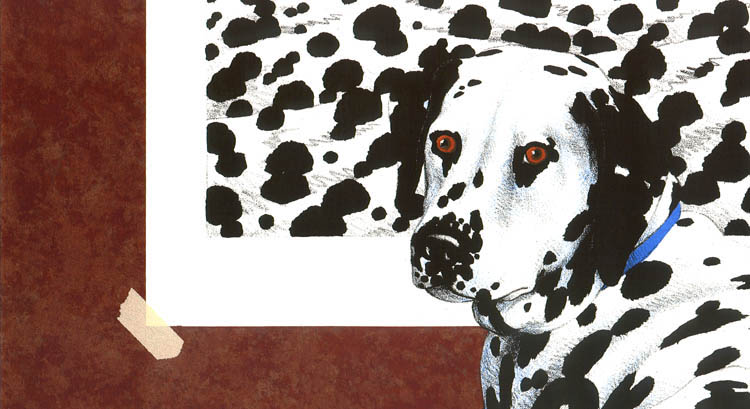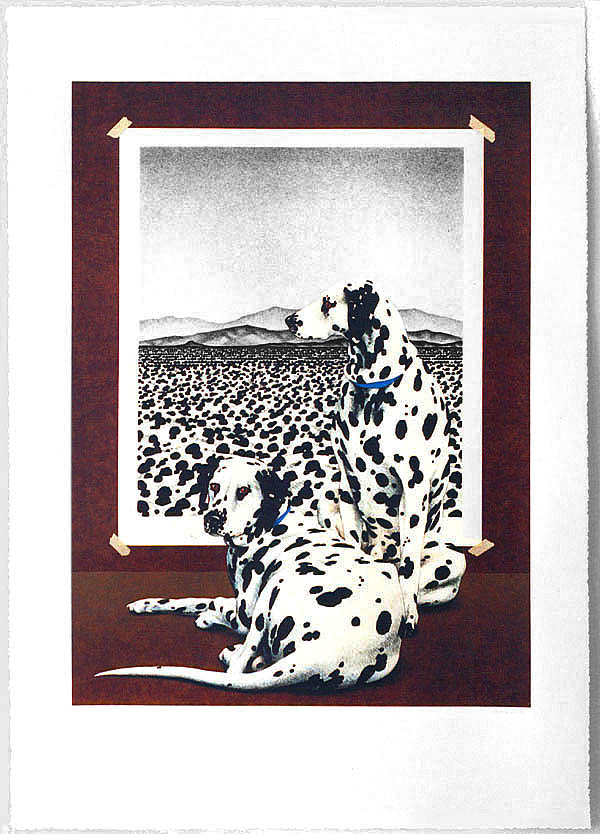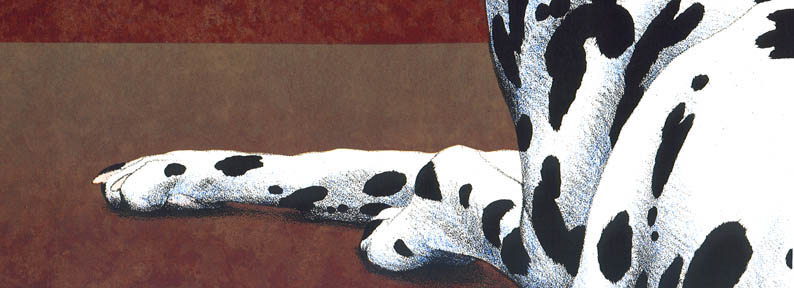



... Dick Mason's fingers must have had charcoal on them when he decided to use the landscape drawing as a backdrop in TWO BLUE COLLARS. Close scrutiny reveals thumb-print smudges on the masking tape affixing the drawing to the wall.
In many of Mason's earlier paintings, soft pastels of the New Mexico landscape revealed a romantic, 'ethereal qualitv in the subject matter. The understated repetition and reduction of information drew the viewer into the composition and effectively expressed the soft silence of the land and sky. The intricate details of the masonry of prehistoric Pueblo and Peruvian ruins were another common theme in Mason's works. Again, the artist demonstrated the visual intrigue of repeated, intricate patterning in the simplicity of a desert environment. Mason is even more focused when discussing his own work. 'I see my new work as an attempt to bring drawing onto the same level of prominence as painting,' says Mason. 'In the last few years, the public has not been that interested in drawings, and there have not been that many quality drawings to see. I integrate painting and drawing to bring new interest to a neglected medium."
Bringing new interest is just what Mason does, his popularity has grown over the years to make him one of the most sought-after artists represented by Elaine Horwitch Galleries. His formal treatment of subject matter combined with the elegance and beauty of his paintings puts him in the category of a specialfew. The analytical purposefulness of the artist holds the viewer to investigate his work beyond recognition of the subject matter . Says Mason, 'My work raises the questions of just what is reality, and what is illusion, and what role does our own creativity play in them.' Seeking the mystery in an artist's work, it has been asked where the artist derives the personal selection of his subject matter. Answers Mason, with a touch of mischief, 'Some of my images are personal metaphors, and some are riddles, but that's my secret.'
Such specificity suggests that a Mason painting is a photographic compendium of visual facts. The sensitively rendered toenails and pads of the Dalmation's feet, the spots that cluster on his snout, the artist's signature for the painting located in trompe l'oeil fashion on the right-hand corner of the drawing -all add up to a rather grand indoor portrait of a dog whose dappled hide is camouflaged against a drawing of the outdoors.
Mason is hardly the first artist to paint a portrait of a dog. All breeds of canine have appeared in family portraits or genre scenes, where they most often are symbols of the people who own them. Patient little court dogs cower at the feet of their mistresses painted by Titian, elegant greyhounds beg for table scraps at the feasts of noblemen painted by Veronese, faithful beagles gaze admiringly at gentrymen in paintings by Thomas Gainsborough and an anthropomorphized mutt mourns at the coffin of his owner in a painting by Sir Edwin Landseer.
It's rare, however, for a dog to be pictured at center stage, stripped of its ownership, as would appear to be the case in Mason's painting. Yet there are clues to the animal's possessor. The flat, clinically monochromatic setting in which Spot waits was clearly arranged by a careful hand. His submissive gaze is not directed at the viewer but acknowledges someone more important outside the picture. Spot's jazzy red collar was obviously picked out by someone with "color consciousness" ... and there is that landscape drawing against which Spot is purposefully positioned so that his head completes the line of the distant mountains and his spotted rump replicates the folds of pinyon-studded desert.
The signed drawing with which Spot merges is, for all practical purposes, his "name tag." And should we question whether the signature "D. Mason" was forged, remember that we have those fingerprints on the masking tape-the artist's unquestioned stamp of ownership.
Susan Hallsteii
Dick Mason's Spotted Landscapes
By Julie Sasse
For the new collector, the name Dick Mason is synonymous Dalmatians. Often, when hearing Mason's name, the response is, 'Oh, yes, he's the dog painter, isnt he?' In reality, Mason has an enormous repertoire of images and compositions, and his recent series of paintings including his pet Dalmatian gives only a hint to the enormous talent of this Santa Fe artist. Sophisticated in presentation and technically masterful, these mixed-media paintings draw the viewer in to explore the uncanny visual correlations between the New Mexico landscape and the spotted, curvilinear forms of the animals Mason holds dear. Importance is placed on contrasts of light and dark within the composition, while textural interplay is cleverly presented using a combination of acrylic paint and pencil on canvas. Such intricate subtleties as the texture of the dog's coat contrasted with the fine weave of a nearby armchair offset by the illusion of a drawing on paper tacked to the wall all demonstrate the extent of Mason's abilities and the intention of the artist to concentrate on artistic concepts, not just pretty pictures of dogs. Says Mason, 'Placing pattern against pattern and utilizing what I call a 'Magrittesque' placing of subject against ground allow me to juxtapose reality against illusion. On some of these canvases, the artwork and background appear more real than the environment in which I placed them. This creates some strange two- and three-dimensional ambiguities that I find successful.
A deep, rich palette of somber earth tones and the startling contrast of whites and blacks
for surprisingly dynamic paintings of serene settings. Further tension is created when, through an open window, a storm is shown slowly brewing or the dark envelope of night is depicted.
New Mexico Patterns - Paintings By Dick Mason
Dick Mason may be called a Southwestern painter because of his residence in Santa Fe, New Mexico, and the influence of the Southwestern locale upon his selection of subject matter. However, the originality and excitement of Mason's art resides less in his subjects than in the irony and technical virtuosity of his style. NEW MEXICO PATTERNS, a survey of Mason's work from 1981 to 1991, documents the artist's application of the 19th-century studio tradition of trompe l'oeil to the landscape and cultural artifacts associated with Santa Fe. It is a fascinating picture of landscape metamorphosed into still-life, decorative pattern translated into illusion, and an eclectic art history vocabulary distilled into a distinctive Dick Mason vocabulary.
By the time he painted the SANGRE DE CRISTO MOUNTAINS in 1981 Mason had established his characteristic landscape style. Disposed by temperament and training to the neat crisp forms of the architectural draftsman, Mason identified with the austere clarity of his surroundings. To emphasize this quality he simplified the panoramic vista of foothills and distant mountains into overlays of undulating contours surmounted by an utterly flawless flat plane of blue sky. He defined the local vegetation of piiion trees and juniper bushes as a simple pattern of brown and green dots resembling, particularly in this image, layers of ever darker-colored and more densely woven tweed fabrics.
Very early on in his work, this inclination to artful form extended into the realm of visual punning. In FIGURE STUDY #3, 1981, the artist experimented with the idea of juxtaposing unrelated subjects. He presented an elegantly drawn male figure which obviously belonged to a studio setting superimposed over one of his panoramic landscape vistas. The disproportionate scale of figure and background and the media differentiation between drawing and painting further pressed the distinction of the two subjects. Then, as if to underline the artificiality of the image, Mason playfully continued the background dot pattern of piiion trees into the area of the figure, clothing it in spotted tights.
Mason really began to explore the aesthetic of trompe l'oeil in his paintings of ancient walls. Following visits to such historic sites as Chaco Canyon National Monument in New Mexico, Mesa Verde in Colorado, and the ruins of Incan cities in Peru, the artist created several series of paintings devoted to the stonework produced by these ancient cultures. Mason's initial approach to the subject was to present an opening in a wall, a doorway or window, which framed a distant view of his now familiar dotted hills. In successive works he closed off the outside world and narrowed his focus to the stonework itself. Concentrating upon the texture of the stone, Mason experimented with the illusionistic effects of con-Lbining paper collage with paint to create an actual relief surface.
Walls and landscapes had begun to say the same things for Mason. The isolated presentation of the stonework as subject asserted the preendnence of geometric pattern as well as the poetics of silence, simplicity, and timelessness. However, the wall studies also advanced the artist's interest in the mystique and intellectual gamesmanship of the painted illusions afforded by trompe l'oeil. Mason not only combined real and painted three-dimensional forms, he started painting gold-leafed metal icons in stone niches--elegantly crafted fantasies inspired by the worlananship of Incan art, Roman sculpture, and the classical still-life imagery of the Italian Renaissance. In these paintings he indulged himself in the pleasures of minute recreations of sensuous materials and object surfaces complete with the flaws of wear.
Mason brought all of these interests together in his portraits of his dalmatian "Spot," images in which the earlier, humble pinon tree dot triumphed with a vengeance. The sleek dalmatian, totally divorced in subject reference from Southwestern genre, made a perfect declaration of artifice. It was also a ready-made graphic motif. Mason played upon the rhymes of Spot's black and white coat with cloud patterns against dark sides or the dotted Santa Fe hills. This led him to abandon his landscape colors for black and white plus the pencil medium to create a painted illusion of an etching. The naturalism of the dog served as a foil for the deliberate artifice of the illusionary print; the artist then increased the complexity of the idea by adding such deceptive details as painted pieces of masking tape to hold the "prints," or smudged inky fingerprints on the "print" corners; and finally began to erode all notion of a simple or innocent naturalism through amplifications of the "print within a painting" image to "dog within a print, within a painting, within a painting."
In the work of NEW MEXICO PATTERNS Mason has crafted a vocabulary to evoke both the sensuality and ambiguity of real things.
Novelene Ross
Chief Curator